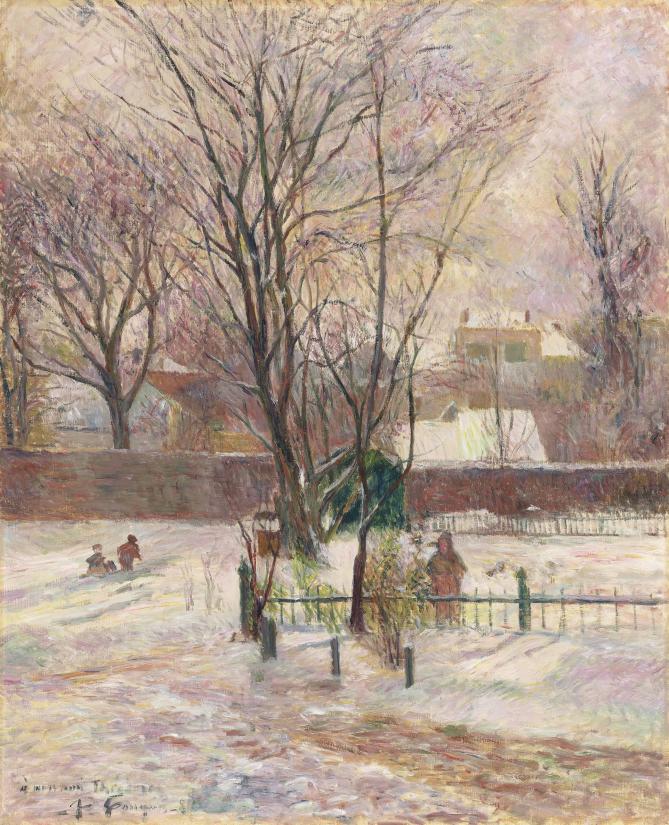Gauguin was feeling optimistic when he first moved to Copenhagen. His urge to paint was strong, and he was fascinated by snow. He painted several winter scenes during this time in Denmark, and La Neige à Copenhague – the snow in Copenhagen – from 1884 is one of them. It probably shows the view of the family’s courtyard garden from their ground-level flat at Gl. Kongevej 105. Gauguin moved to Copenhagen in November 1884 with his Danish wife, Mette Gad, and their children, after losing his job as a stockbroker the previous year. His attempts at establishing a career as an artist in Normandy had failed, money was tight, and the family saw no option but to settle in Copenhagen, close to Gauguin’s in-laws. His time in Denmark enabled him to explore a different range of topics than the ones he is more widely known for.
Atmospheric lightness
La Neige à Copenhague shows the snow-covered garden with slender trees. The most striking aspect of the scene is the light. The delicate naked branches of the trees against the violet sky cast shadows on the snow in the foreground. Two children are playing on a toboggan. A little greenery peeks through the snow here and there. A wall cuts across the image, and in the background, snowclad gardens and houses can be glimpsed. Snow allowed Gauguin to explore a lighter, more atmospheric style of painting, which stands in contrast to his later, intensely colourful works.
Winter scenes from Copenhagen
The cold made it difficult to work outdoors, but Gauguin still managed to paint several winter scenes during his time in Copenhagen, including Skøjteløbere i Frederiksberg Have (Skaters in Frederiksberg Gardens), which is included in the collection at the Glyptotek. Despite the optimism he felt when he first arrived in Denmark, Gauguin felt isolated. He did not speak the language, and he was not successful in his employment as the Scandinavian sales representative for a tarpaulin manufacturer. His only real outlet was painting. And thus, he was left with little to do but paint during his time in Copenhagen, which lasted just under a year. The result was a considerable production of paintings, drawings, watercolours and photographs.
La Neige à Copenhague is included in a small special exhibition at the Glyptotek titled Paul Gauguin og den danske forbindelse (Paul Gauguin and the Danish Connection) from 1 May 2022. The purchase of the painting was supported by the Augustinus Foundation, Aage og Johanne Louis-Hansens Fond and the New Carlsberg Foundation.
About Paul Gauguin
Paul Gauguin (1848–1903) was born in Paris but put out to sea at the age of 17 and spent the next 6 years sailing the world’s oceans. In 1872 he settled in Paris, where he was employed in a large firm of stockbrokers. Soon after, he married the Dane Mette Gad, with whom he had five children. When Gauguin lost his job as a stockbroker, he was free to pursue a dream of becoming an artist. However, he struggled to provide for his family, and in 1884 they had to move to Copenhagen, close to Mette Gad’s family. The family stayed in Copenhagen while Gauguin returned to Paris and later travelled to Tahiti, where he remained until 1901, apart from a brief interruption from 1893 to 1895. In Tahiti he sought to revitalize his art, immersed in daily life with the Polynesians and their outlook and way of life.



